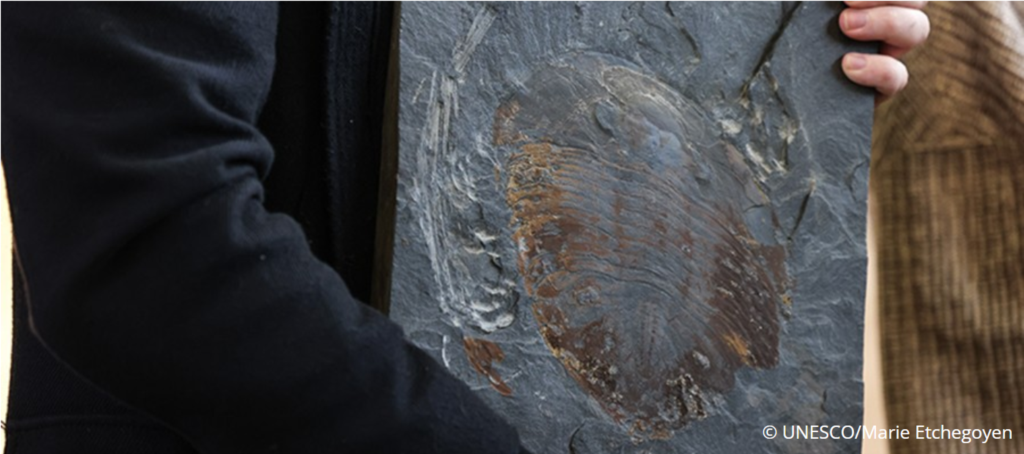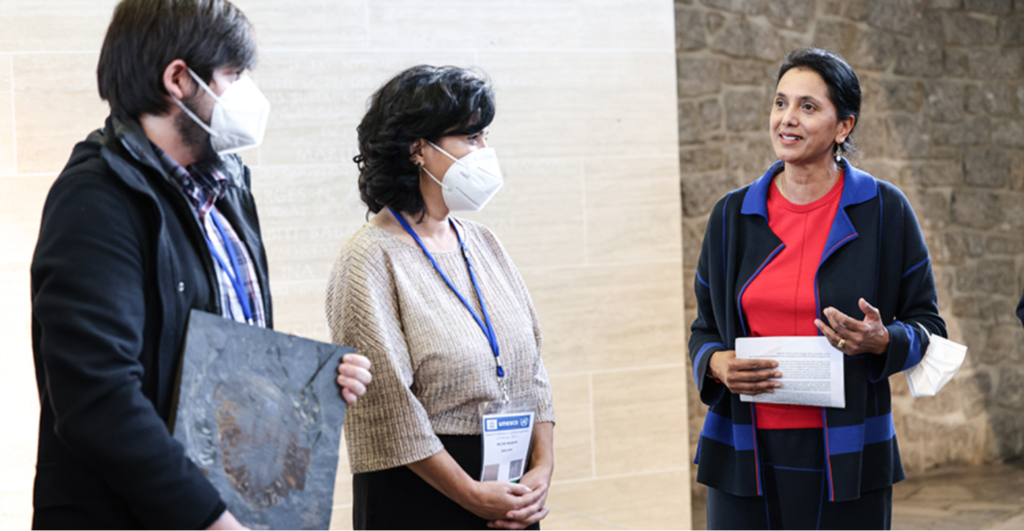
A trilobite fossil dated from the Middle Ordovician (~467-458 Ma) of the Arouca UNESCO Global Geopark in northern Portugal was donated to UNESCO today. Ambassador António Nóvoa, Permanent Delegate of Portugal to UNESCO, and two representatives from Arouca, Margarida Belém, mayor of Arouca and Manuel Figueiredo, gifted the fossil to Shamila Nair-Bedouelle, Assistant Director-General for Natural Sciences of UNESCO. It is now displayed in the exhibition that celebrates the 75th Anniversary of UNESCO, at the organization’s headquarters in Paris, France.
Ambassador Nóvoa reminded the audience that Trilobites (meaning "three lobes") are one of the the most successful organisms to have lived on Earth, living throughout the Paleozoic (541-252 Ma) from the Early Cambrian. Compared to them, humans have been around for only a blink of time. Yet, despite being extremely well adapted to their environment, they became extinct in the large mass extinction that marked the end of Permian, which was probably caused by large quantities of CO2 emitted in long-term volcanic eruptions. The Ambassador further reminded the audience that Arouca’s fossil heritage is truly unique and was conserved thanks to the passion and commitment of Manuel Valério, owner of the quarry where they were discovered.
The ceremony was an opportunity to pay homage to Manuel Valério, who was the inspiration behind the Arouca UNESCO Global Geopark. His son, Manuel Figueiredo, brought the fossil to the ceremony and shared touching anecdotes of his father’s scientific curiosity and desire to pass on this heritage to the next generations, driving him to protect these fossils, despite the fact that their excavation and study slowed down the works in the quarry.
The Assistant Director-General expressed her appreciation on behalf of UNESCO for this donation, which reflects in her view the close cooperation that UNESCO has maintained with the Geoscience community, under the International Geoscience and Geoparks Programme, which will celebrate its 50th anniversary next year. The Proclamation of an International Geodiversity Day (6 October) by the Member States by the ongoing 41st session of the General Conference of UNESCO brings further recognition of the importance of the protection of our geological heritage and a more sustainable management of our natural resources, ideas that come together in this donation from Portugal.
The mayor of Arouca shared her joy that one of the famous Arouca fossils has found a new home in UNESCO, an organization that inspires what they want to achieve with the Geopark and its community.
Finding a unique geological heritage in a quarry
There were over 20.000 species of trilobites, and they lived on Earth for nearly 300 Ma. Some moved over the seabed – such as the fossil specimen donated by the Arouca UNESCO Global Geopark belonging to the Asaphida order - as predators, scavengers, or filter feeders, and other species swam, feeding on plankton. Some even crawled onto land. Most lifestyles expected of modern marine arthropods are seen in trilobites.
The trilobite fossils found in the Arouca UNESCO Global Geopark in Portugal are amongst the largest to have been discovered and the rock formation where they are found – the Valongo Formation - one of the most prolific in the world. The Geological Interpretative Center of Canelas, also known as the Trilobite Museum, created in 2006 in Canelas, a small parish of Arouca Municipality, provides a window into a past when the continental masses where gathered in the supercontinent Pangea. Most of the trilobites from Arouca come from the “Valério Quarry”, a slate quarry that has been in operation since 1820 providing high-quality slate to be used in roofing and wall tiling around the world.

© UNESCO/Marie Etchegoyen
When Manuel Valério, the quarry owner, reopened the quarry in the late 1980s, he became fascinated by the trilobites found in some of the layers. Instead of ignoring them and seeing the findings as a complication for his business, he began collecting the fossils. Whenever the quarry workers intersected the trilobite bearing beds, works proceeded with care in order to remove the fossils and preserve them. Along the years he gathered a great collection of trilobites and became familiar with the geological history of the region and of these fascinating animals. With his passion for the history of the planet and dedication to the preservation of the local geological heritage, Manuel Valério was one of the key promoters of the Arouca UNESCO Global Geopark, together with members of the scientific community such as the geologist Artur Sá, who wrote his doctoral thesis in the Ordovician of Arouca and is now the scientific coordinator of the Geopark. Sadly Manuel Valério passed away shortly before one of the famous Arouca Trilobites found a home in UNESCO.
As territories with a geological heritage of international importance, UNESCO's Global Geoparks demonstrate they are also territories for local and sustainable economic development, quality education and resource preservation.
At a time when human-induced climate change is the most pressing issue of our time and urgent measures to stop the planet from heating above 1.5ºC are needed, the geological record provides direct insight on what can happen when CO2 levels rise abruptly. Fossils such as the Arouca trilobites are a reminder of that even very successful and well adapted species can become extinct when the environmental changes are so rapid that adaptation and survival becomes impossible.

Photos: © UNESCO/Marie Etchegoyen